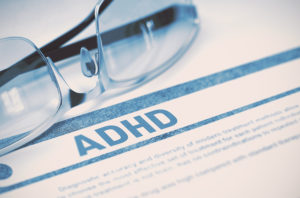Diagnosis
A diagnosis of ADD/ADHD in a child, adolescent or adult requires that certain criteria must be met, according to the guidelines in the American Psychiatric Association’s Diagnostic Statistical Manual, Fifth Edition (DSM-5). This includes the number of inattentive and/or hyperactive-impulsive symptoms present and the duration of those symptoms, among others. These criteria also differ between children, adolescents and adults. A child must have a minimum of six ADD/ADHD symptoms for a diagnosis to be considered, while an adolescent or adult must have at least five symptoms. As an example, troubles with paying attention, easily getting distracted and talking excessively are not enough symptoms to warrant a diagnosis. Moreover, these symptoms must have been present for at least six months prior to a diagnosis being made, and they are inappropriate for the person’s developmental level (Centers for Disease Control and Prevention, 2017).
 Additional diagnostic criteria of ADD/ADHD include symptoms that are significant enough to impair school, work or social functioning. Symptoms must also occur in at least two different settings, such as at school or work, home and in social situations. Additionally, the symptoms can not be better explained by other existing mental disorders, such as depression and/or anxiety. It is important for a diagnosis to be sought out if ADD/ADHD is suspected, as this is the first step towards treatment, which can dramatically improve quality of life.
Additional diagnostic criteria of ADD/ADHD include symptoms that are significant enough to impair school, work or social functioning. Symptoms must also occur in at least two different settings, such as at school or work, home and in social situations. Additionally, the symptoms can not be better explained by other existing mental disorders, such as depression and/or anxiety. It is important for a diagnosis to be sought out if ADD/ADHD is suspected, as this is the first step towards treatment, which can dramatically improve quality of life.
Treatment
Once a doctor has made a diagnosis of ADD/ADHD, he or she may recommend one or more different treatment strategies, such as behavioral therapy, school accommodations, nutritional improvements and/or medication. In children under the age of six, behavioral therapy is recommended over medication. Behavioral therapy for children often involves the parents and teaches them how to help their children manage their symptoms. It also helps young children to learn about new ways to cope with their symptoms, in addition to eliminating problematic behaviors. Children over the age of six and adolescents may receive a combination of behavioral therapy and medication. In adults, common treatment options include psychotherapy, medication or a combination of the two. The type of therapy a person receives will depend on his or her age, individual needs and the recommendations of the physician (Centers for Disease Control and Prevention, 2017).
Interested in learning more about ADD/ADHD research? Please call 561-296-3820. The Premiere Research Institute in West Palm Beach regularly conducts clinical research studies in the field of ADD/ADHD. To find out more about these studies click here or sign up for their newsletter to keep informed about the newest treatments, articles, and research that are being conducted in the field of ADD/ADHD.
References:
Centers for Disease Control and Prevention. Attention-deficit / hyperactivity disorder (ADHD): Symptoms & Diagnosis. (2017, August 31). Retrieved from https://www.cdc.gov/ncbddd/adhd/diagnosis.html
Centers for Disease Control and Prevention. Attention-deficit / hyperactivity disorder (ADHD): Treatment. (2017, May 31). Retrieved from https://www.cdc.gov/ncbddd/adhd/treatment.html
Johnson, J. (2017, January 12). “ADD vs. ADHD: Is There a Difference?” Medical News Today. Retrieved from https://www.medicalnewstoday.com/articles/315158.php.
